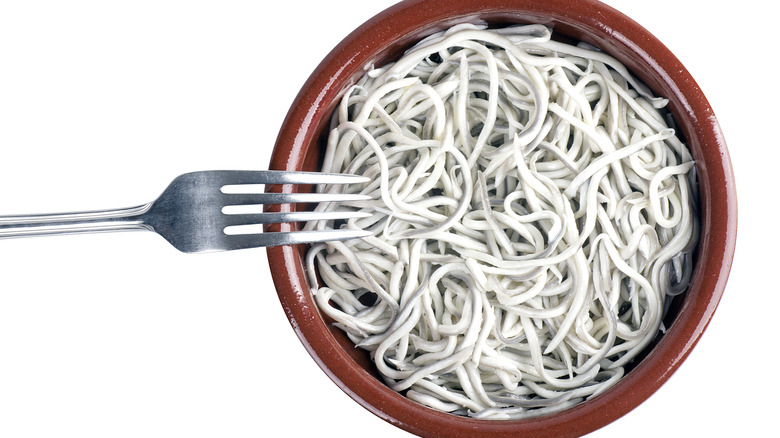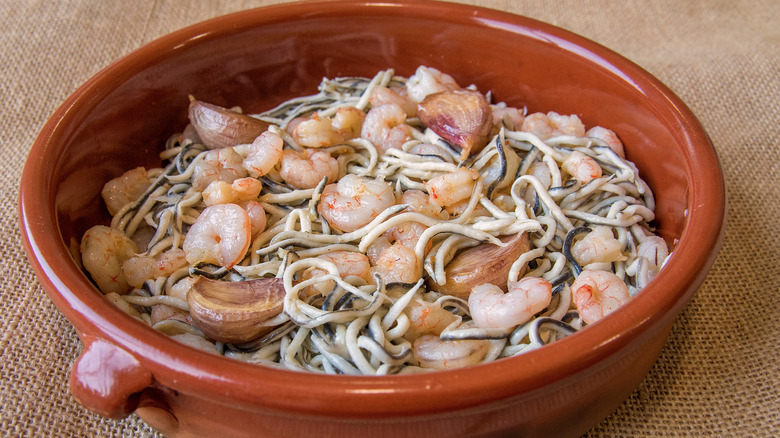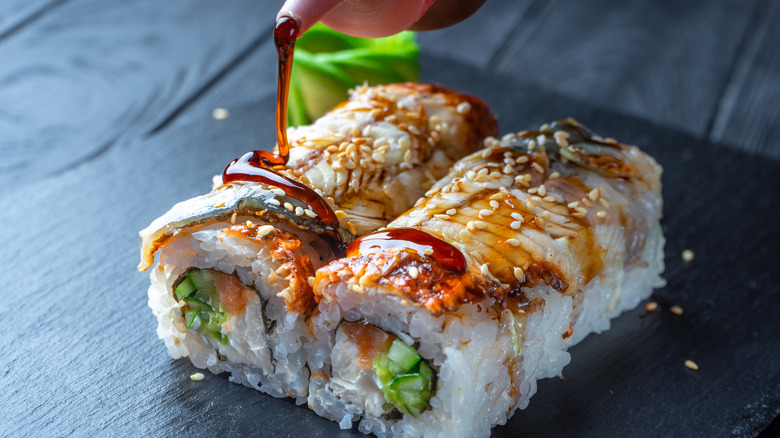Why Are Baby Eels So Expensive?
Baby eels are among the most fascinating creatures on Earth, since, as New Scientist reports, no one really knows where baby eels come from. Well, we have an idea, obviously ... but no one has ever seen eels mate or spawn, and their migratory routes are virtually unknown save breeding destinations somewhere in the Sargasso Sea. Mysterious as they may be, this isn't why baby eels are famous. Rather, baby eels are best known for fetching enormous prices in restaurants. A few years back, First We Feast noted that U.S.–sourced baby eels were going for $2,000 per pound. In Spain, where the baby eels are known as angulas and prized as delicacies, BBC Travel confirmed they were going for 1,000 euros a kilo.
At this point, you may have some questions. Like, do they even taste good? And also, if their flavor isn't life-changing, just what about them is worth paying so much money for? Rodrigo Garcia Fonseca, a chef at a Basque restaurant in Madrid called Arima, sheds light on both questions (via BBC Travel): "I wouldn't pay that money for them. They have no taste, no color, nothing, not even smell. A lettuce has more aroma. But I had two guys in here that ordered half a kilo of them. Five hundred euros in one shot. Some people who have money like to spend it. Who doesn't like being a snob from time to time?"
Limited supplies driving up prices for baby eels
Can baby eels' appeal really be so base as snobbery and conspicuous consumption? No, it's more complicated than that. Part of the problem is scarcity as global supplies are limited for a variety of reasons. Europe has banned eel exports due to a steep decline in their numbers in the region, and many Japanese fisheries were damaged in the 2011 earthquake and tsunami, per Scientific America. In China, baby eels (aka elvers or glass eels), which are needed to seed aquaculture farms, are also becoming increasingly scarce, as National Geographic observed.
This pressure on traditional supplies led to a boon for U.S. fishermen, particularly in Maine. Since 2014, however, Maine has imposed a strict quota on eel fishing, further adding to the market pressure. So in addition to legitimate supplies, a black market also emerged, spurred by the high prices and even higher demand, especially in Japan and China. More than 20 illegal smugglers were taken down in a multistate wildlife trafficking operation in the United States in 2018, per National Geographic, 19 of whom were sentenced to fines or prison terms. In 2019, the South China Morning Post reported that baby eels were being smuggled into Japan through Taiwan and Hong Kong. Taiwan, it should be noted, also bans eel exports.
Restaurants drive increased demand
Limited supply and market pressure have helped to drive the outrageous prices for baby eels, but prices are also being inflated by their use in Michelin-starred restaurants, notably in Spain. "When I was young, in the 1950s and '60s, we ate a lot of angulas," said food writer and historian Manolo González, quoted in BBC Travel. "At that time, they were still considered too low class for a restaurant to serve, but in the '70s, the great Basque restaurants like Arzak started to cook with them, and all of a sudden, angulas were high class."
Spanish cuisine prizes baby eels, and so does Japanese sushi. As The New Yorker writes, Japanese consumers alone account for 100,000 tons of eel per year, or roughly 75% of the global catch. For Japan, eel is a cultural and culinary institution. Thus consumption numbers have continued to rise, despite the shortages and rising prices. The overfishing of Japanese eel populations has resulted in declining domestic catch numbers in recent years, hitting a historic low in 2019. However, domestic eel returns were on the rise again in 2020, according to SeafoodSource.


